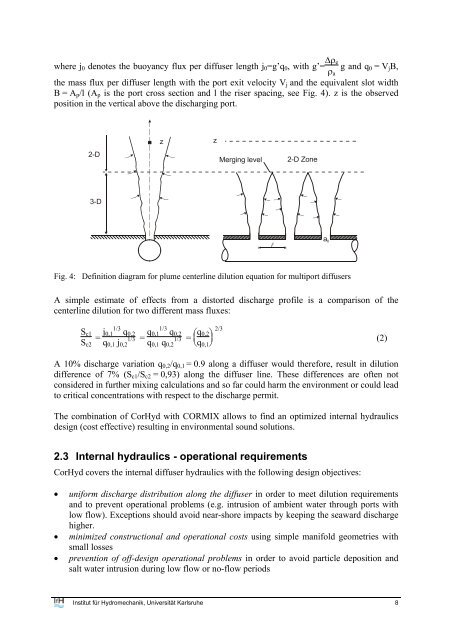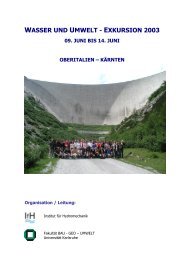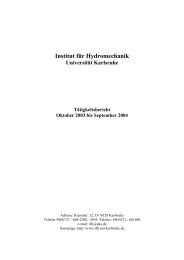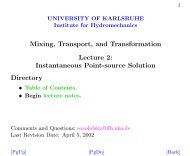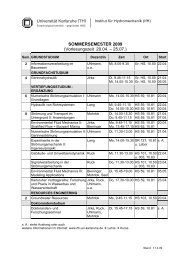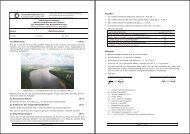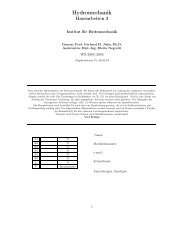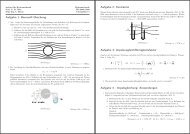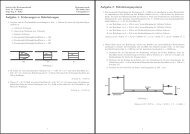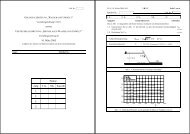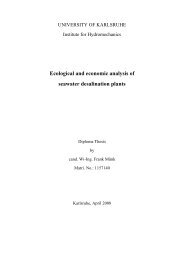user's manual for corhyd: an internal diffuser hydraulics model - IfH
user's manual for corhyd: an internal diffuser hydraulics model - IfH
user's manual for corhyd: an internal diffuser hydraulics model - IfH
You also want an ePaper? Increase the reach of your titles
YUMPU automatically turns print PDFs into web optimized ePapers that Google loves.
where j 0 denotes the buoy<strong>an</strong>cy flux per <strong>diffuser</strong> length j 0 =g’q 0 , with g’= ∆ρ e<br />
ρ a<br />
g <strong>an</strong>d q 0 = V j B,<br />
the mass flux per <strong>diffuser</strong> length with the port exit velocity V j <strong>an</strong>d the equivalent slot width<br />
B = A p /l (A p is the port cross section <strong>an</strong>d l the riser spacing, see Fig. 4). z is the observed<br />
position in the vertical above the discharging port.<br />
2-D<br />
z<br />
z<br />
Merging level<br />
2-D Zone<br />
3-D<br />
l<br />
a 0<br />
Fig. 4: Definition diagram <strong>for</strong> plume centerline dilution equation <strong>for</strong> multiport <strong>diffuser</strong>s<br />
A simple estimate of effects from a distorted discharge profile is a comparison of the<br />
centerline dilution <strong>for</strong> two different mass fluxes:<br />
S c1<br />
S<br />
= j 0,1 1/3 q 0,2<br />
1/3<br />
c2 q 0,1 j<br />
= q 0,1 1/3 q 0,2<br />
1/3<br />
0,2 q 0,1 q<br />
= ⎜ ⎛<br />
0,2 ⎝<br />
2/3<br />
q 0,2<br />
q 0,1<br />
⎠ ⎟⎞<br />
(2)<br />
A 10% discharge variation q 0,2 /q 0,1 = 0.9 along a <strong>diffuser</strong> would there<strong>for</strong>e, result in dilution<br />
difference of 7% (S c1 /S c2 = 0,93) along the <strong>diffuser</strong> line. These differences are often not<br />
considered in further mixing calculations <strong>an</strong>d so far could harm the environment or could lead<br />
to critical concentrations with respect to the discharge permit.<br />
The combination of CorHyd with CORMIX allows to find <strong>an</strong> optimized <strong>internal</strong> <strong>hydraulics</strong><br />
design (cost effective) resulting in environmental sound solutions.<br />
2.3 Internal <strong>hydraulics</strong> - operational requirements<br />
CorHyd covers the <strong>internal</strong> <strong>diffuser</strong> <strong>hydraulics</strong> with the following design objectives:<br />
• uni<strong>for</strong>m discharge distribution along the <strong>diffuser</strong> in order to meet dilution requirements<br />
<strong>an</strong>d to prevent operational problems (e.g. intrusion of ambient water through ports with<br />
low flow). Exceptions should avoid near-shore impacts by keeping the seaward discharge<br />
higher.<br />
• minimized constructional <strong>an</strong>d operational costs using simple m<strong>an</strong>ifold geometries with<br />
small losses<br />
• prevention of off-design operational problems in order to avoid particle deposition <strong>an</strong>d<br />
salt water intrusion during low flow or no-flow periods<br />
Institut für Hydromech<strong>an</strong>ik, Universität Karlsruhe 8


